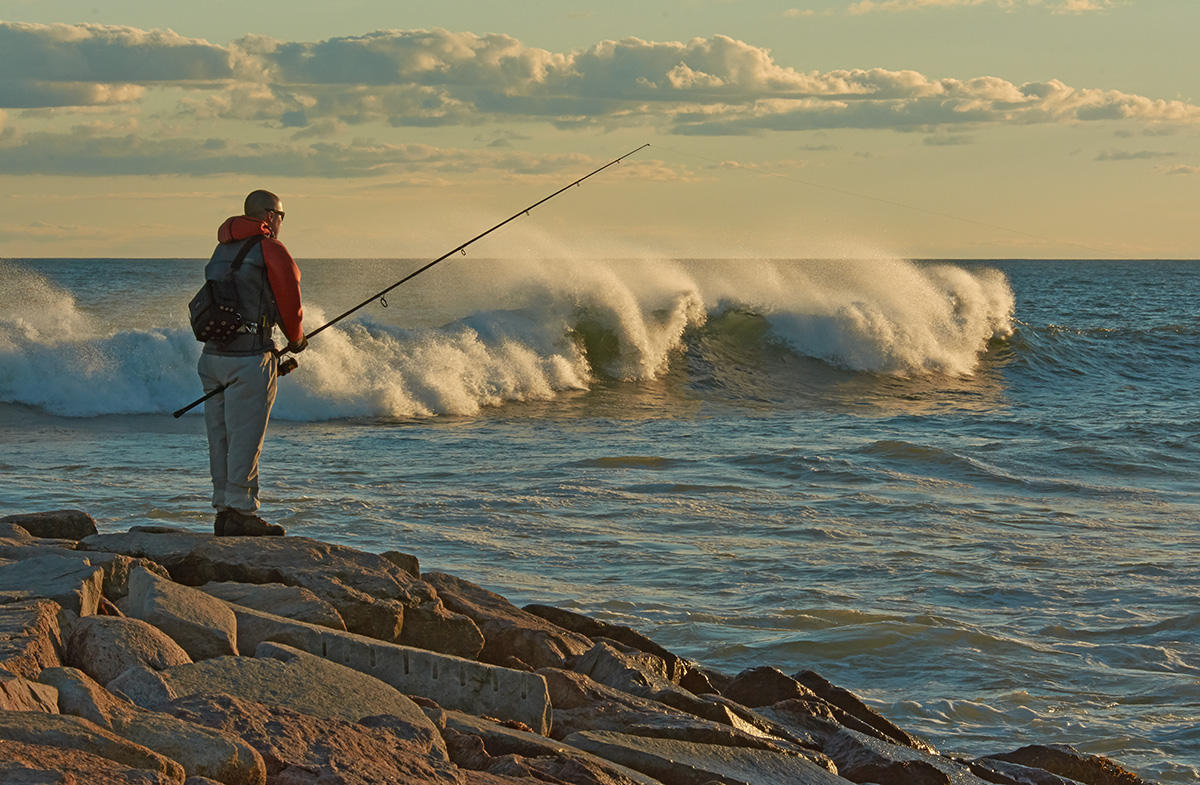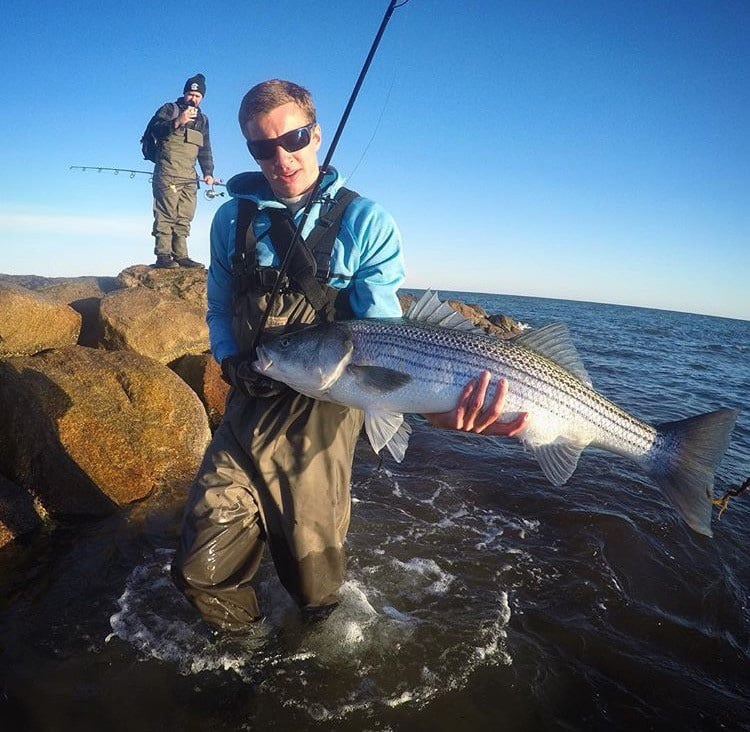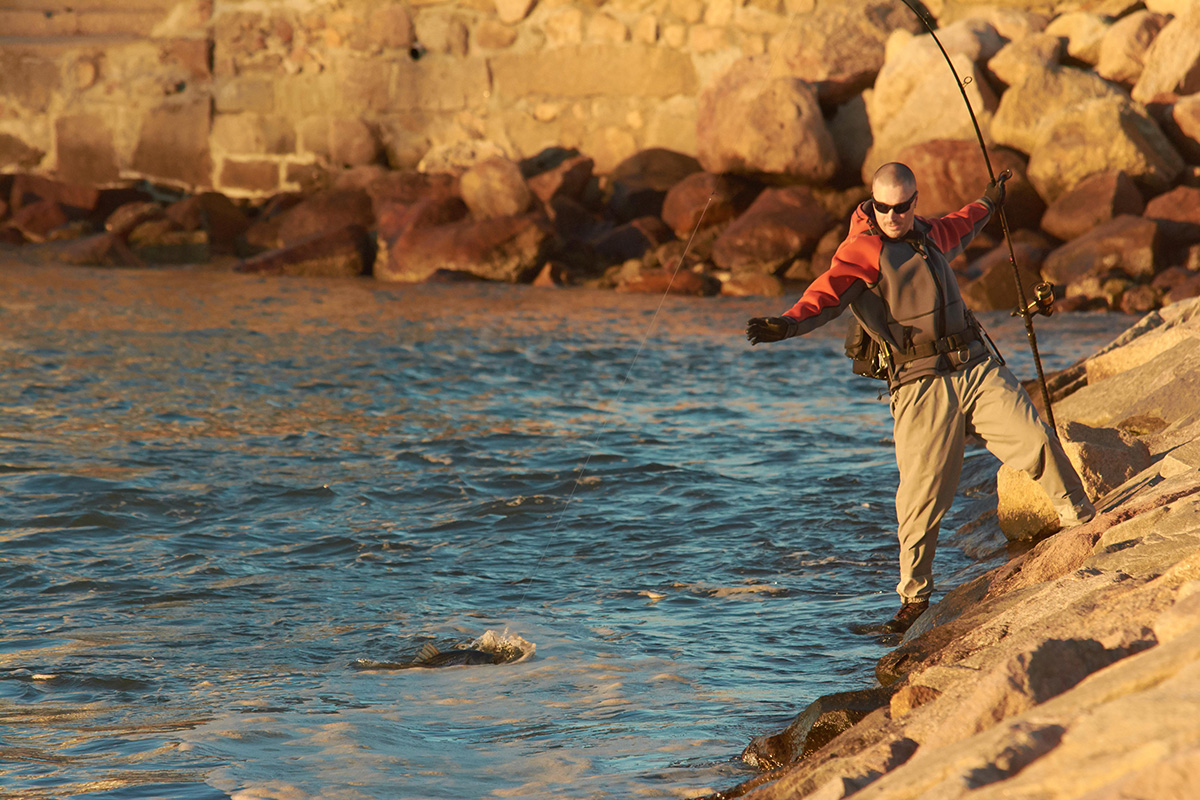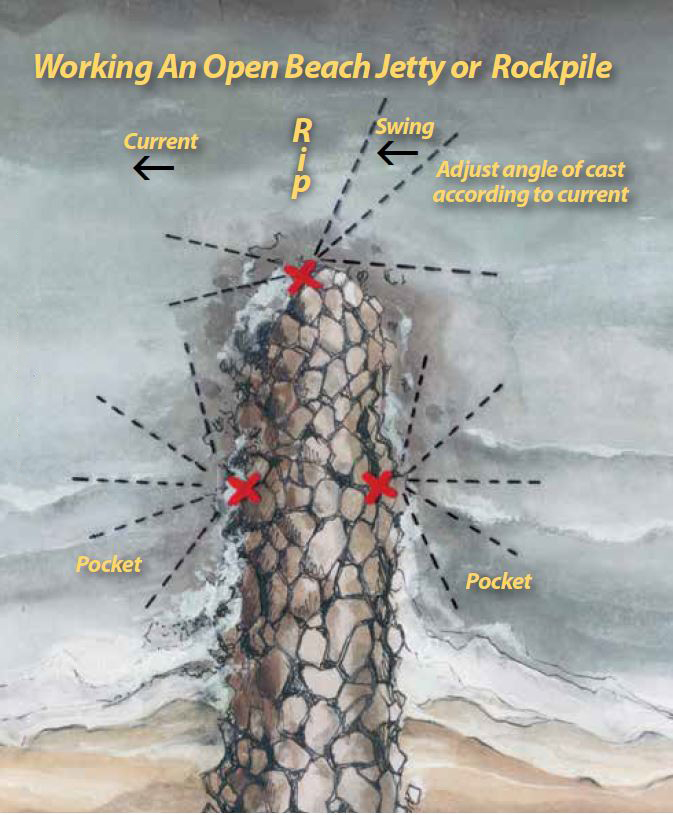
Whoever coined the name rockfish for striped bass knew what he or she was talking about. Striped bass have a definite fondness for rocky shorelines, jetties, and the abundant forage that is found among this rocky terrain. While sandy beaches can be highly productive for stripers at times, especially during the fall migration, rocky areas rate highest on the list of striped bass real estate. It’s no coincidence that places like Montauk, Block Island and Cuttyhunk are premier surf fishing locations when it comes to targeting stripers. Jetties or rockpiles along lengthy stretches of sand beach are like an oasis to stripers, and should be on the radar of every surfcaster. The rocks harbor prime striper forage in the form of mussels, crabs, lobsters and especially juvenile blackfish, sea bass, scup, bergalls and other structure oriented species.
Oceanfront Jetties
When working jetties or rockpiles that protrude along sandy beaches and even along rocky shorelines, it’s never a bad idea to scout the surrounding water at low tide on a clear, sunny day. Look for rocks scattered along the bottom surrounding the jetty, and any depressions, pockets of deeper water, or channel edges within casting distance. Some of these structures, especially those in close proximity to an inlet or breachway, and certainly those that fall within inlet shorelines, will have enough current passing by to create a noticeable rip. The more time you spend working a particular rockpile or jetty, the better you will get to know where fish set up on a particular tidal stage, and the best angle of presentation. Even jetties that don’t possess the added benefit of these types of structure hold fish. Until you “learn” a jetty, take the time to fish it thoroughly. If you can safely access the tip, fan cast from 3 o’clock to 9 o’clock and always work some casts parallel along both sides of the rocky structure, especially on jetties that lack surrounding structure. Minnow-style swimming plugs are good tools for working along the edge of a jetty. Surface swimmers get the job done often enough, but I find very few casters who include sinking models of the same plugs in their jetty bag. For years, a 5-1/2-inch sinking, mackerel finished Rebel was my go-to lure for working tight to jetties with fairly deep water surrounding the structure. A recent check of the Rebel website showed only the original floating model, but Daiwa’s SP Minnow comes in a sinking model and is widely available. One advantage to the sinking plugs is that you can work them effectively right to the edge of the jetty without having the plug break the surface of the water where it loses its swimming action and becomes ineffective. This is an important consideration with surface models also and takes a little extra effort to keep them working effectively. The higher your position on the jetty, the more difficult it becomes. But you should always keep your rod tip as close to the surface as possible, which means for many surfcasters, changing the position of your rod from between your legs, to holding it off to your side. Keeping the rod between your legs and bending all the way over to keep your tip down will do nothing for your back as many surfcasters can attest. Danny style swimmers, both surface and sub-surface, are also effective around the rocks. My favorite is patterned after a blackfish or bergall, both of which rate high on a striper’s menu. During the September mullet run, the migrating baitfish hug the rocks as they move down the beach. Blue minnow style plugs and blue Danny style surface plugs can do some serious damage when bass are riding herd on the mullet schools.
When working the perimeter of a jetty, surface plugs like pencil poppers and standard poppers are always worth tossing, especially at dawn and dusk. Bucktails should be a part of every jetty bag and can be worked tight to, or away from the jetty. If a rip forms off the tip of the jetty, angle your cast to the upcurrent side of the rip and allow the jig to swing down and into the rip. Adjust the weight of your bucktail and the angle of your cast according to the strength of the current and water depth (faster current = 2 o’clock / slower current 1 o’clock). Working these same rips after dark with swimming plugs or darters is also very productive.
If big stripers are your objective, few offerings are better than a live or rigged eel, regardless of where you are fishing. Casting unweighted live eels from a rocky perch is a simple and surefire way to cull out a quality striper.

Inlet Jetties
Most inlets and breachways are framed by jetties that jut out well beyond the shoreline. The oceanside pockets formed by where the jetty meets the beach are natural barriers to baitfish, making them stopovers for gamefish on that same migratory path. Depending on the length of a jetty, some can be worked more effectively from the side of the jetty itself, while others are easily fished from shore. Working the pocket from the jetty provides more options when it comes to presentation; you can fan cast the pocket or work your offering parallel towards the tip of the jetty or towards shore. The obvious advantage of working from shore is it is much easier landing fish, and you can do it safely in your waders without the need for cleated soles or Korkers. On some jetties, you are able to work your way off the rocks and land a big fish on the beach, but more on landing fish later.
Current and Tide
On many inlet jetties, the best fishing often occurs on the inlet side of the jetty or at the tip where typically strong currents form rips and eddies where gamefish set up during various stages of the current. Notice I said current, not tide. Current is the horizontal movement of water in and out of bays and inlets. Tide is the vertical rise and fall of water. Along the open beach on jetties where there is little current, the stage of tide generally has the most impact on fishing activity. Some jetties fish better at high water, others on a rising or dropping tide. In the case of inlet jetties or breachways, you’re fishing different stages of the current. Knowing the difference is critical because the difference between high tide and high slack current can vary as much as three hours in some areas. In Fire Island Inlet on Long Island for example, there is an hour and 45 minute difference, meaning that if high tide is at noon, the current will continue running in until it goes slack at around 2:45 depending on conditions like wind and moon stage, which can affect the difference. Once you know the difference for the area you fish, it is easy to calculate the current based on high tide tables.
While many surf fishermen believe the outgoing current is most productive, there are some inlets that fish very well on the incoming. In either case, stripers set up in rips and back eddies, normally tight to the bottom when the current is running. That makes bucktails, leadheads tipped with soft plastics and weighted swim shads ideal choices for getting down to the fish. Even more so than fishing a rip off the tip of an oceanfront jetty, it is critical to come up with the right combination of lure weight and casting angle to put your offering in the strike zone due to generally deeper water and stronger currents. That formula changes as the current increases or decreases. More times than not, when the bite turns off, it means your lure is no longer hitting the strike zone, unless you make the necessary adjustment (changing the casting angle/lure weight).
Don’t get caught up in concentrating your efforts only when the current is running. Many casters call it quits as rips and eddies fade away yet some of the best fishing can occur at the end and start of an incoming or outgoing current. Also, as slack water approaches, bass leave their feeding stations in fading rips and prowl tight to the rocks looking to cull crabs and other forage from among the rocks. This is an especially good time to work a swimming plug parallel to the jetty. Some of my biggest stripers have come around the turn of a tide, so don’t be so quick to bail when the current slows.

Gear Up
It’s often been written that the ideal rod for working jetties is something in the 8-foot range. While that may be true on steep jetties where if you are fishing at the base, you have little room for your back cast, those situations are rare. Also, there are many situations where you will be combining fishing a jetty or rockpile with fishing the adjacent open beach, making a longer rod a better choice. Standard 10- and 11-foot surf rods provide other advantages as well. They make retrieving your lure over outlying rocks easier and also provide an advantage in landing and fighting fish by helping to keep your line clear of rocks.
When it comes to line, I’m comfortable with fishing 30-pound test braid for all-around surf use, which includes jetty work. Other casters I know insist on using a minimum of 40-pound, while others are more comfortable with 50- and even 60-pound when fishing around rocks. While braid does lack the abrasion resistance of mono, staying with the lighter 30-pound test, in some cases even 20-pound test, the lighter line provides advantages in presentation and the ability to get lighter and smaller offerings down to the strike zone in moving water, or standard offerings during moon tides. While some might scoff at 20-pound test, I’ve seen it make a difference enough times to at least consider the risk.
More important than your line is what is at the end of it. Long leaders of 4 feet or so, or a shock leader connected by a double-uni, modified Albright or FG knot serve multiple purposes. It is a handle for landing and controlling fish once you get them alongside the rocks, and will take the brunt of the abrasion caused by barnacles and rocks. Fluorocarbon is always a good choice but if you don’t want to spend the extra bucks, a good abrasion resistant mono like pink Ande, which did the job long before fluorocarbon came along, still gets the job done.
Landing Fish
There is no one good answer to landing fish from a jetty since the nature of the jetty, sea conditions and tide all factor into how you go about it. That long leader or shocker goes a long way toward helping land fish, regardless of the conditions. I don’t think I have to tell anyone to never, never try to land or lift a fish by holding onto your braid unless you enjoy getting stitches, but you never know. I’ve seen dumber things on the beach.
All jetties and rockpiles are different. Some can be safely negotiated down to the water line, making it easy to land and release fish. Others make it more difficult to get down to your fish, or surf conditions require you stay a safe distance above the water. In these cases, there is no substitute for a long handled gaff with a relatively small hook (a 3-inch gap works) at the end. Since most of the stripers, and very likely big blues, you hook will be destined for release, the long gaff can be used to snag your lure, allowing you to slide the fish up the rocks if it is hooked well, or to pull the hook free (Crushing the barbs on the trebles of your plugs helps free a hook.). The gaff also allows you to slide a fish back down into the water instead of heaving it from atop the jetty. I’ve seen enough fish fall short of the water and go bouncing off rocks to make it worth avoiding that practice when possible. Small fish can be lifted onto the jetty, and are generally easy to toss “gently” back into the water without falling short, but always try to get as close to the water as is safely possible when returning a fish.
Safety First
The golden rules of jetty fishing are don’t wear waders and always wear metal studded footwear like Korkers when negotiating jetties and rockpiles. The reality is that these rules are broken more times than not. Some flat-topped jetties might be perfectly safe in waders, especially if you are combining beach fishing with some time on the jetty and you have no intentions of climbing down below on moss covered rocks to retrieve a fish or snagged lure. But – there are plenty of situations when you’d better follow the rules and that means wearing foul weather pants instead of waders, and a good pair of cleats. If you find yourself doing a lot of jetty fishing, investing in a pair of Korkers is a no-brainer. If you are on tight budget, get yourself a cheap pair of rubber galoshes that will fit over a pair of sneakers and screw some sheet metal screws through the soles that the ends of the screws protrude through the sole. That will keep you safe until you can spring for the real thing.

Always make sure a jetty or groin is safe before venturing out and know the stage of the tide. Watch the surf for washovers and stay off if there is any question about it being safe. Too many casters have been swept off rocks and more than a few of these cases have not ended happily.
Something else to think about if you are trying to retrieve or break free a snagged lure from the rocks. Always hold the rod to your side when walking or pulling back, and turn your head away from the snag. Some years back, a Long Islander fishing the Jones Beach West End Two jetty was trying to break free a bottom rig connected by 50-pound line. The pyramid sinker came free and shot back like a bullet, penetrating the man’s eye socket, hitting his brain, and killing him on the spot.
Jetties and rockpiles can yield great rewards. Treat them with respect, use common sense and you should be able to reap the many benefits of these fish attracting structures.



